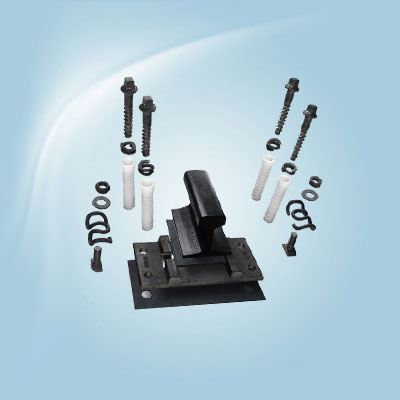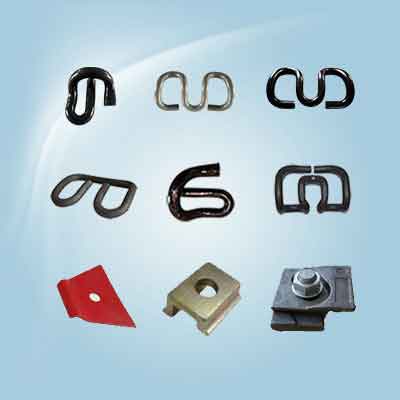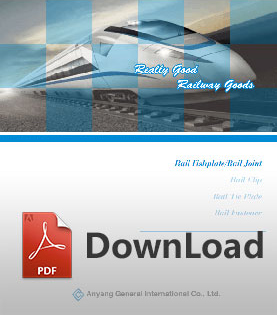Railroad fasteners in the world – RN/Nabla/ Vossloh Fastening System Overview
Apr 30, 2015
Installation and Functional Requirements of railroad fasteners
Railroad fasteners are an important component of rail track and it is always used to connect track rails with railway ties or railway sleepers. In general, the rail fastener fixes the correct position of track rails in order to avoid the horizontal and vertical displacement as well as the rollover. What’s more, it can also provide well elasticity and insulating property and do well in gauge adjusting.
Before the rail track is laid in the plate and the holes are drilled, the tie plates should be positioned on a new tie. It is placed canted so that the cant can run to the center of the tie. It is recommended that the tie is tamped before clip installation. As to the taller, raised heel seat is the field side of the plate. With the tie plate centered, the pilot hole should be drilled for the screw spike. After that, a visual check should be made to insure that the plate fasteners are all the way down and the tie plate is tight against the tie.

As we all know , the railway track is well connected to the transportation of the society. A railway transportation system requires a large-scale investment and the engineering procedure including basic construction, business operation and so on. It is composed of steel rails, fastening system, railway ties and ballast, among this , each unit comprises different components with certain physical and chemical properties.
The main stream types of railway fasteners in Countries
In current days, railway fasteners used in the market have a variety of types. They are assembled with other components as independent units, which can be fixed as a whole and can also offer under controlled vertical, longitudinal, and transverse forces to avoid excessive displacement. And the widely and mainly used railroad fasteners in the global market are those: vossloh W type of Germany, Stedef Nabla fastener and RN fastener of France and e type fastener, PR type fastener.

The RN and Nabla are widely used in the countries of Africa and Southeast Asia. In the early 1960s, Japan imported the RN clip fastening system and improved it. After that, the new production is called 102 clip fastening system and used in the construction of Tokaido Shinkansen.
| Fixed Type | Appearance | Names of Fasteners Used |
|---|---|---|
| Bolt Type | Steel Bar | Germany-vossloh W type |
| Steel Plate | France-Stedef Nabla fastener and RN fastener | |
| Japan-102 type fastener | ||
| Steel Block | Germany-K type fastener | |
| Non-Bolt Type | Steel Bar | E type fastener, PR type fastener and FastClip |
| The Netherlands-DE fastener | ||
| The US-Sidewinder fastener | ||
| Switzerland-Fist fastener | ||
| Sweden-Hambo fastener | ||
| Steel Plate | Australia-Mc Kay Safelok | |
| Safelok | ||
|
Australia:Rex-Lok
|
France
France is one of the first countries to adopt elastic fasteners in the world, and since 1950s , the RN clip fastening system has been used in the rail track. With the development of high-speed railway, we change to use elastic bars with a shape of double curvature arch. In the other word, it is called Nabla clip fastening system.

| Nabla clip | Insulator | Screw spike | Spring washer | |
|---|---|---|---|---|
| Pieces required | 2 | 2 | 2 | 2 |
| Material | 60Si2MnA, 60Si2CrA | Reinforced Nylon 66 (PA66) | Grade5.6:35# | ML08AI |
| Size | 4mm or 4.5mm thick | UIC54,UIC60,50kg rail,60kg rail | 18.25x34x78mm | |
| Note | 42-47HRC 3 million times without breaking; Application for different rail type | Density:1.3-1.45g/cm3 Tensile strength:≥170Mpa Elongation:≤4.4% Bending Strength:≥250Mpa Impact Strength(No gap):≥80KJ/m2 Melting point:250-270℃ Insultion resistance:≥1X108Ω Glass fiber content:30-35% Hardness:≥110HRR |
The RN and Nabla are widely used in the countries of Africa and Southeast Asia. In the early 1960s, Japan imported the RN clip fastening system and improved it. After that, the new production is called 102 clip fastening system and used in the construction of Tokaido Shinkansen.
With the appearance of slab track, Japan has made more fasteners for slab track such as the 4, 5 or 8 clip fastening system. They all use the elastic bar as the railway fasteners.
During the working process of traditional railroad fasteners, the bending deformation of material performance is mainly used. The production process is relatively simple and also tend to be low cost. In order to meet the requirement of bolts fastening, some holes are designed. Stress can easily focus on this part and lead to damage easily too. On the contrary, the elastic bars can use both the bending deformation of material performance and the torsion deformation of material performance. So it owns a good elasticity which contains a high-usage. As we all know , the famous world class railway fasteners like Vossloh are all using the elastic bars in the railroad fastening system.
Germany
German high speed railway uses Vossloh rail fastener with bolts and shoulders. It is consist of five parts such as elastic bar, gauge apron, bolt, plastic casing and elastic cushion. The elastic cushion is placed in the rail ditch between rail tracks and rail sleepers. Lateral position is fixed through the gauge apron under the pressure of elastic bar. The elastic bar has a shape like “w” and the type is SKL14. Gauge apron is with materials like engineering plastics which plays an important role in keeping gauge and insulation.



China
The railway fastening system mainly includes fasteners and elastic cushion. And in China , the common fasteners are the type I, II and III. Among them, the type I and II are all with rail shoulders and bolts. But, as to type I, it has a low strength margin safety factor and the clamping force of fastener is also poor. In this case, the type I is always replaced by type II which is made up to improve insufficient of type I. And the type III is the fastener without bolts and shoulders. It is totally used in the current railway track. But it cannot adjust the rail surface height and gauge so the application field is limited. Besides, there are so many common fasteners used in the rail track, such as WJ-7, WJ-8 etc.

Global railroad fasteners forecast
In recent years, with the development and the progress of railway construction, it becomes more strict to the requirement of railroad fasteners. Both Fastclip without rail shoulders or bolts and Vossloh with bolts or shoulders are all have their own advantages. Each railroad fastener has to adapt to the high-speed railway in order to achieve the desired effect. So in the process of railway development , the railroad fasteners are still play an important role.
CATEGORIES
- Rail Fasteners
- rail fastening system
- rail clip
- railroad spike
- Track bolt
- rail shoulders
- rail anchor
- rail clamp
- tie plate
- Rail Pad
- rail insulator
- rail plastic dowel
- other rail fasteners
- Railway Switch
- SKL series rail fastening system
- Chinese standard rail fastening system
- screw spikes
- Crane rail fastening system
- K type rail clip for Africa
- Hey-Back Rail Fastening
- rail fasteners for Mexican market
- Ss25 screw spike
- Ss35 rail sleeper screw spike
- Ss8 screw spike
- coach screw
- Crane Rail Clip
- Rail Joints (Fishplate)
- Steel Rail
- Railway Sleeper
Hot Sale Products
rail fastening system
 rail clip
rail clip
 rail joints
rail joints

Product Brochure
Product Brochures,Instant FREEDownload
We Respect Your Email Privacy,We Hate Spam As Much As You Do!
 Español
Español English
English

